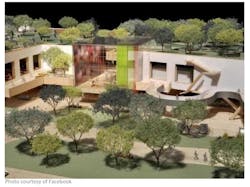Chicago’s historic Wrigley Building renovated to attract tech companies
Located on Michigan Avenue, alongside the Chicago River, sits the historic Wrigley Building. The building is celebrating its 90th anniversary this year. It is owned by a consortium of investors led by BDT Capital Partners and includes Zeller Realty Group, as well as Eric Lefkofsky and Brad Keywell personally, as minority investors. This consortium of investors have recently renovated and reimagined the next life for this architectural landmark.
According to a recent article published on line by BlueSky Innovations, the renovations were geared towards attracting tech companies in the area. Turns out, Chicago has a pretty strong tech community in its River North neighborhood, with only 10.7% vacancy compared to the overall rate of 14.9%, according to CBRE.
The Wrigley Building expects 15% of its total occupants will be represented by tech companies, with legal and investment firms taking up the rest of the leased space.
So, how do you redesign an old building to attract new industry?
Well, you think modern and add some unexpected amenities. In this case, a shared lounge with a fireplace and baby grand piano should do the trick. It’s just the thing to say, Hey, this isn’t your grandfather’s office space.
As is the case with most tech companies, the flexibility of open, collaborative workspaces mixed with smaller work/meeting rooms is key to creating the right office environment. But don’t think that this is just about amenities; it’s about catering to a new type of office worker, one who is most likely under the age of 30 and enjoys being part of a thriving company. And by thriving I mean an often blurred line between company time and “me” time. Giving employees perks that encourage collaborative sessions during (and after) work hours means a greater likelihood of creating a stronger sense of community within the company overall.
It just so happens I know a thing or two about this topic. The software company I work for is one of the first technology tenants to sign on and redefine this historic landmark.
When participating in the office space planning meetings with our CEO, we looked for inspiration from our own customers in Southern California. We visited Gensler’s new headquarters in downtown Los Angeles, where we saw strategically placed meeting rooms designed to promote smaller collaborative meetings. We saw DPR’s Newport Beach, Calif., office, equipped with an innovation lounge and coffee bar specifically designed to allow impromptu meetings and idea sharing.
So in our new Chicago office we decided to take advantage of the sweeping views at the most narrow point of the building, opting not to fill the narrow space with cramped workstations, but rather a winery-style bar. Knowing some of our best collaborative conversations happen at a bar, over a pint, we decided to give our employees the best seat in the house to do some of their best creative thinking.
Facebook CEO Mark Zuckerberg knows a thing or two about balancing the need for collaboration with structured spaces. In fact, during a tour of Gehry Partners' office recently, I was told the story of Zuckerberg’s initial reluctance to have Frank Gehry design his new headquarters. Seeing the highly engineered structures Gehry is known for, Zuckerberg was skeptical his open, collaborative environment would not be appropriately translated.
Gehry asked Zuckerberg one simple question: What do you like about your current space? Zuckerberg said he liked the fact that it was a big open warehouse with very few walls. Gehry’s solution was to create an expansive, single-level, open-floor-plan, warehouse—like office space elevated over what would be the parking lot.
Since Zuckerberg also likes to take walking meetings during the day, Gehry put a park with walking paths on top, with skylights to allow light to stream through exposed ceilings. From the outside you can’t tell if it’s a park or a commercial building. And you definitely wouldn’t guess it’s a Frank Gehry design.
Chicago doesn’t have the luxury of open space like Menlo Park, but smart building owners are taking cues from tech tenants, reimagining their designs to offer the utmost flexibility with built-in, unexpected amenities.
One thing an urban area like River North has over Menlo Park is public transportation. Many of the new tech companies in Chicago boast about how upward of 90% of their employees either walk to work or take public transportation. That’s a valuable perk, as it means the employees have more control over how they spend their time getting to and from work.
I’m also convinced the new tech tenants in River North are rubbing off on all Chicago residents. In a press release from October 2013, Mayor Emanuel announced that the city will go paperless by 2016, putting all of its permitting services online. Mary O’Conner, 41st Ward Chicago Alderman, says she’s “pleased to work with Mayor Emanuel to bring forward these reforms, so Chicago stays the most friendly city in the world for small business, and continues to grow jobs in our neighborhoods.”
Plans for the city’s paperless initiatives go into effect this year.
About the Author

Sasha Reed
As Vice President of Strategic Development at Bluebeam, Inc., Sasha Reed collaborates with leaders in the architecture, engineering and construction industry to guide Bluebeam’s technology, partnerships and long-term goals. She joined Bluebeam in 2007 and co-created the Concierge Approach, a distinctly branded process of customer engagement, product feedback and solution delivery to which much of Bluebeam’s success is attributed, and which today is replicated at every organizational level.
Sasha is known industry-wide as a “conversation facilitator,” creating platforms for exchanges necessary to digitally advance the industry, including the BD+C Magazine Digital COM Blog, which she authors and manages. She’s been a featured presenter at numerous national and international conferences, including the 2014 Design-Build Institute of America (DBIA), Federal Project Delivery Symposium and NTI Danish BIM Conference. Sasha also co-chairs the Construction PDF Coalition, a grassroots effort to provide a common industry framework from which to create and maintain construction PDF documents, serves on the City College of San Francisco BIM Industry Council, and is Advisor to the Board of Direction for the National Institute of Building Sciences BuildingSMART Alliance.


